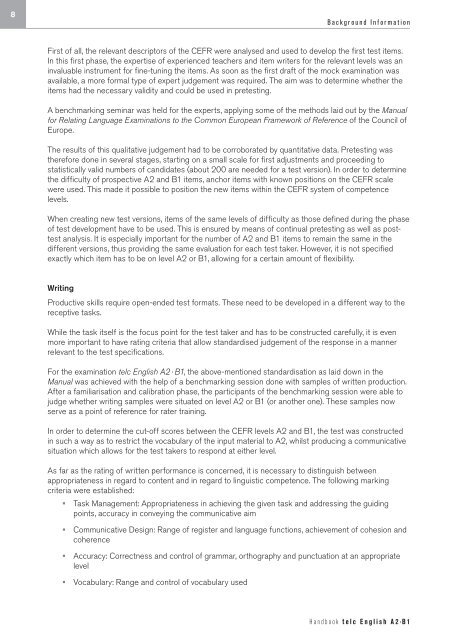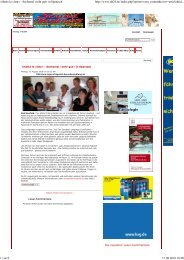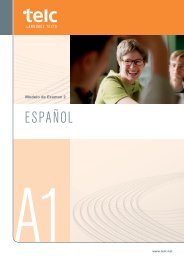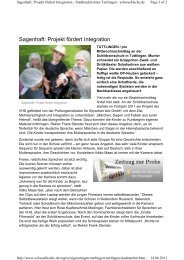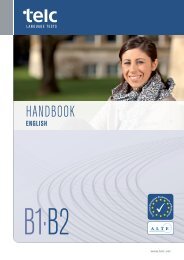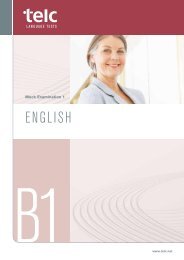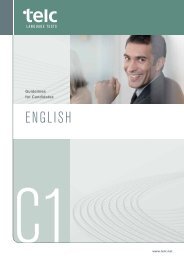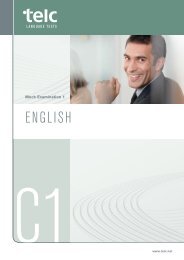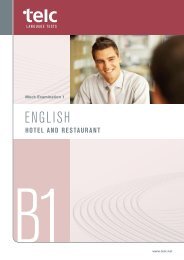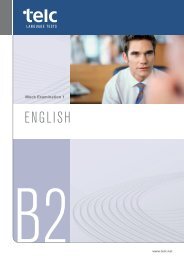Download Handbook (PDF, 4,3 MB) - telc GmbH
Download Handbook (PDF, 4,3 MB) - telc GmbH
Download Handbook (PDF, 4,3 MB) - telc GmbH
Create successful ePaper yourself
Turn your PDF publications into a flip-book with our unique Google optimized e-Paper software.
8<br />
Background Information<br />
First of all, the relevant descriptors of the CEFR were analysed and used to develop the first test items.<br />
In this first phase, the expertise of experienced teachers and item writers for the relevant levels was an<br />
invaluable instrument for fine-tuning the items. As soon as the first draft of the mock examination was<br />
available, a more formal type of expert judgement was required. The aim was to determine whether the<br />
items had the necessary validity and could be used in pretesting.<br />
A benchmarking seminar was held for the experts, applying some of the methods laid out by the Manual<br />
for Relating Language Examinations to the Common European Framework of Reference of the Council of<br />
Europe.<br />
The results of this qualitative judgement had to be corroborated by quantitative data. Pretesting was<br />
therefore done in several stages, starting on a small scale for first adjustments and proceeding to<br />
statistically valid numbers of candidates (about 200 are needed for a test version). In order to determine<br />
the difficulty of prospective A2 and B1 items, anchor items with known positions on the CEFR scale<br />
were used. This made it possible to position the new items within the CEFR system of competence<br />
levels.<br />
When creating new test versions, items of the same levels of difficulty as those defined during the phase<br />
of test development have to be used. This is ensured by means of continual pretesting as well as posttest<br />
analysis. It is especially important for the number of A2 and B1 items to remain the same in the<br />
different versions, thus providing the same evaluation for each test taker. However, it is not specified<br />
exactly which item has to be on level A2 or B1, allowing for a certain amount of flexibility.<br />
Writing<br />
Productive skills require open-ended test formats. These need to be developed in a different way to the<br />
receptive tasks.<br />
While the task itself is the focus point for the test taker and has to be constructed carefully, it is even<br />
more important to have rating criteria that allow standardised judgement of the response in a manner<br />
relevant to the test specifications.<br />
For the examination <strong>telc</strong> English A2 · B1, the above-mentioned standardisation as laid down in the<br />
Manual was achieved with the help of a benchmarking session done with samples of written production.<br />
After a familiarisation and calibration phase, the participants of the benchmarking session were able to<br />
judge whether writing samples were situated on level A2 or B1 (or another one). These samples now<br />
serve as a point of reference for rater training.<br />
In order to determine the cut-off scores between the CEFR levels A2 and B1, the test was constructed<br />
in such a way as to restrict the vocabulary of the input material to A2, whilst producing a communicative<br />
situation which allows for the test takers to respond at either level.<br />
As far as the rating of written performance is concerned, it is necessary to distinguish between<br />
appropriateness in regard to content and in regard to linguistic competence. The following marking<br />
criteria were established:<br />
• Task Management: Appropriateness in achieving the given task and addressing the guiding<br />
points, accuracy in conveying the communicative aim<br />
• Communicative Design: Range of register and language functions, achievement of cohesion and<br />
coherence<br />
• Accuracy: Correctness and control of grammar, orthography and punctuation at an appropriate<br />
level<br />
• Vocabulary: Range and control of vocabulary used<br />
<strong>Handbook</strong> <strong>telc</strong> English A2·B1


